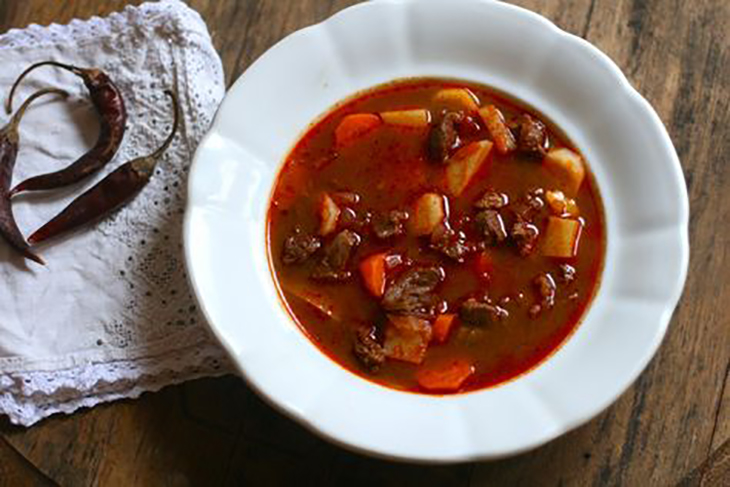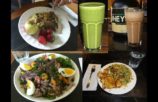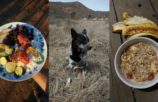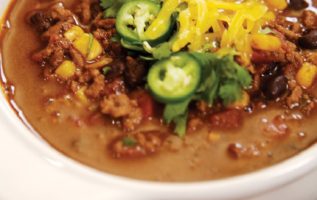
Gulyás (known as goulash to non-Hungarians), that iconic Hungarian paprika-spiked beef soup, is not a regular in my kitchen. Why make it at home when it is served at nearly every Hungarian restaurant in Budapest? I love a good bowl of gulyás, and even served it to a crowd of visitors on the night before my wedding. But truth be told, I’ve been goulashed out for awhile now. I’ve avoided ordering and eating it for so long now (which I can partially blame on the fact that there’s just so much new and good stuff to taste in Budapest these days) that it came as a pleasant surprise recently when my husband’s bowl of gulyás at a restaurant looked so good to me that I ended up eating half of it. And then, a few days later I made a big pot of it at home.
As Hungarian recipes go, gulyás is a simple dish to make and doesn’t require any special ingredients. Once you do all of the chopping, all you need to do is check it occasionally as it slowly simmers and perfumes the house. Since it’s so easy to make a good goulash you would think it would be hard to make a bad one. But it happens, and there is nothing worse than being served a watery, lifeless gulyás with little substance to it.
There are a few rules to making gulyás, but there are many different variations on the recipe. Essentially it is a soup made with beef (or less commonly veal or mutton), lots of paprika (good, sweet Hungarian paprika is essential), very slow-cooked onions, and vegetables (normally carrots, potatoes, and parsley root). Every cook has his or her own preferred ratio. I like mine hearty, the broth rich with lots of meat and vegetables. I add lots of finely chopped onions, since they thicken the broth and add lots more flavor.
The best kind of gulyás, in my opinion, uses several different cuts of beef (George Lang’s recipe calls for an optional piece of beef heart). It’s perfectly fine to use a lesser cut of beef, since if you cook it long enough, the soup will be just fine. In fact, you’d be wasting your money to use an expensive cut. One chef I know always uses beef cheeks, which are wonderful in the soup. As with many Hungarian recipes, you start by slowly sautéing chopped onions in fat (lard or oil). You don’t want the onions to brown, but rather to get clear and glassy, so cook them over the lowest heat possible (this is a good time to gather and prep all of your other ingredients). Next, you’ll stir in a few spoonfuls of sweet Hungarian paprika (being careful not to burn it, since it easily caramelizes in hot fat) and some caraway seeds, add the meat, and pour in the water. Then, you just wait (sometimes for several hours, depending on the cut of meat you used) until it is nearly ready, which is when you add your vegetables. If you have time you can make some csipetke (pinched pasta), but that is not necessary.
In Hungary, a bowl of gulyás is a simple meal, but one that anyone would be happy to eat, whether as the first course at a fancy restaurant, or a one-dish dinner on a Tuesday night. If you have a bottle of not-too-heavy red wine, it will go beautifully with the gulyás. I don’t know why it has taken me so long to get back to cooking gulyás at home. But now that the cooler weather is arriving, I am pretty sure that it will be cooked soon again in my kitchen. Even my husband, a guy who has eaten a lot of gulyás in his life (and is normally the family’s dedicated gulyás maker) loved it. “This might be the best bowl of gulyás I’ve ever had,” were his exact words. Just don’t tell his anya.
The Best Gulyás (Goulash) Recipe
- 3 tablespoons oil or lard
- 5 medium onions, diced
- 2½ teaspoons salt
- 2½ liters (2½ quarts) water, plus a few extra spoonfuls
- 3 tablespoons Hungarian paprika (sweet)
- ½ teaspoon black pepper
- 1 tablespoon caraway seeds
- 1½ kg (3¼ lbs) beef, chopped into bite-sized pieces
- 2 cloves of garlic, chopped
- 5 medium carrots, sliced into bite-sized rounds
- 2 medium parsnip, sliced into bite-sized rounds
- 2 large potatoes, cubed
- 2 tomatoes, diced
- Csipetke (pinched pasta), optional
- Heat the oil or lard in a large pot (preferably a Dutch oven). Add the onions along with a few spoonfuls of water (so they don’t brown) and a pinch of the salt. Cook slowly over very low heat for about 15 to 20 minutes, or until the onions are clear and glassy.
- Remove from the heat and add the paprika, pepper, and caraway seeds. Stir quickly to combine and add a tiny bit of water (to prevent the paprika from burning).
- Add the meat and garlic and cook over high heat, stirring, until the meat is slightly browned (about ten minutes). Turn the heat down to low, add a few spoonfuls of water, and cook for about 15 more minutes, until the meat is nearly cooked through.
- Add the water and keep cooking, over low heat, for at least an hour, or until the meat is cooked and nearly tender enough to serve. This could take hours, depending on the cut of beef you used.
- When the meat is nearly done, add the tomatoes, carrots, parsnips, and potatoes and cook for about 15 more minutes, or until they are tender (being careful not to overcook them). Taste the soup and add more salt and pepper, if needed.
- If you are using csipetke or another kind of small pasta, add it to the soup before serving. You can serve this soup with hot pepper or hot pepper paste.



























